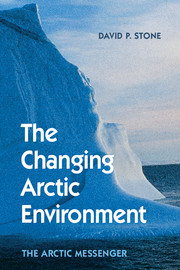Book contents
- Frontmatter
- Dedication
- Contents
- Acknowledgements
- Acronyms
- 1 Personal Beginnings
- PART I THE CHANGING ARCTIC
- PART II WORKING TOGETHER
- PART III WHAT IS THE PRESENT STATE OF KNOWLEDGE?
- 4 Radioactivity
- 5 Heroic Efforts
- 6 Acidification and Arctic Haze
- 7 Stratospheric Ozone Depletion
- 8 Persistent Organic Pollutants and Heavy Metals (Including Mercury)
- 9 Conducting Marine Science in the Arctic
- 10 Climate Change in the Arctic
- PART IV WHAT DOES ALL THIS MEAN?
- Appendix I The Intergovernmental Panel on Climate Change (IPCC)
- Appendix II What Will Happen in the Future If We Do Nothing or If We Try Very Hard to Aggressively Reduce GHG Emissions: Projected Change Under Different Emission Scenarios
- Appendix III Some Geophysical Background Notes Related to Climate and Weather
- Appendix IV Orbital Forcing
- Appendix V The Concept of Commitment
- Bibliography
- Credits
- Index
8 - Persistent Organic Pollutants and Heavy Metals (Including Mercury)
from PART III - WHAT IS THE PRESENT STATE OF KNOWLEDGE?
Published online by Cambridge University Press: 05 February 2015
- Frontmatter
- Dedication
- Contents
- Acknowledgements
- Acronyms
- 1 Personal Beginnings
- PART I THE CHANGING ARCTIC
- PART II WORKING TOGETHER
- PART III WHAT IS THE PRESENT STATE OF KNOWLEDGE?
- 4 Radioactivity
- 5 Heroic Efforts
- 6 Acidification and Arctic Haze
- 7 Stratospheric Ozone Depletion
- 8 Persistent Organic Pollutants and Heavy Metals (Including Mercury)
- 9 Conducting Marine Science in the Arctic
- 10 Climate Change in the Arctic
- PART IV WHAT DOES ALL THIS MEAN?
- Appendix I The Intergovernmental Panel on Climate Change (IPCC)
- Appendix II What Will Happen in the Future If We Do Nothing or If We Try Very Hard to Aggressively Reduce GHG Emissions: Projected Change Under Different Emission Scenarios
- Appendix III Some Geophysical Background Notes Related to Climate and Weather
- Appendix IV Orbital Forcing
- Appendix V The Concept of Commitment
- Bibliography
- Credits
- Index
Summary
And another spirit is at hand,
conceived in the restless city,
growing from the rubbish yards of houses and from smoking factories,
a spirit swelling with confidence,
multi-coloured all-embracing
garish quick-nosed ever pacing.
Dáithí Ó hÓgáin, “Putting Out the Hag” from Footsteps From Another WorldThis chapter tells a tragic story caused by humankind's hubris, “swelling with confidence” in its attitude towards its environment. Here, the Arctic Messenger will tell us how a class of chemicals called persistent organic pollutants (POPs) and some metals (especially mercury) have accumulated through the Arctic ecosystem to top predators and to indigenous peoples. At the heart of the story is the conspiracy of a number of independent properties of these substances that target the Arctic ecosystem. What makes the tragedy so raw is that the potential for this polar conspiracy could have been recognized long before the evidence was stumbled on in the Arctic. As we will see, even more disturbing is the evidence that for POPs, world governments have still only understood and acted on a small portion of the situation described by the Arctic Messenger.
Before we begin, I have a warning. The simplest approach to this chapter would be to describe what we know today about POPs and heavy metals in the Arctic and global environments and to end with a review of the present state of international actions to deal with them. This would have been easy for the reader and for me. But it would have lost the historical perspective of how we came to understand the environ- mental and human health characteristics of these chemicals over the last 30 years. I want the story to be told as it really happened, with science and policy evolving together. When told in this way, the Arctic Messenger's story reveals lessons on the effectiveness of interaction between science and national and international policy.
- Type
- Chapter
- Information
- The Changing Arctic EnvironmentThe Arctic Messenger, pp. 106 - 180Publisher: Cambridge University PressPrint publication year: 2015



